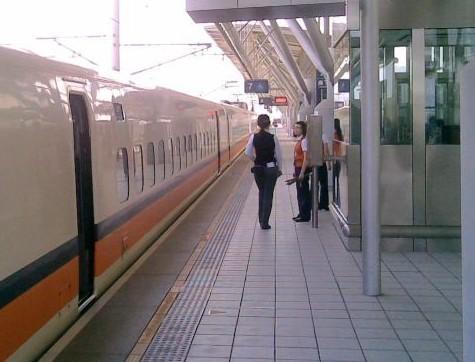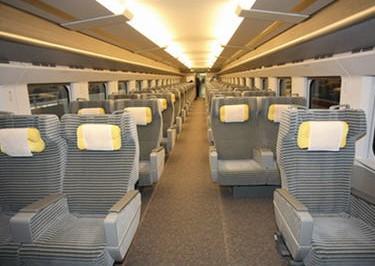Transportation in China
This is a big title in which I will first introduce something about trains in this page.
Train
Chinese trains are divided according to their speed into various
classes, identified with different letters and numbers. The letters
refer to different classes:
G – High-Speed Electric Multiple Units (EMU) Train
This is the fastest running for long distance in China, the top speed
of which could reach 350km/h. Currently, the G-train could finish the
1,068-kilometers Wuhan-Guangzhou High-Speed Railway in 3 hours, the
301-kilometers Shanghai-Nanjing High-Speed Railway in 73 minutes and the
458-kilometers Zhengzhou-Xian High-Speed Railway in 2 hours.
C – Intercity EMU
This is also the fastest kind, but runs for short travel distance
between two nearby cities, such as the 120-kilomter's Beijing-Tianjin
Intercity Railway.
D – Electric Multiple Units (EMU)
This type is also called Hexiehao (和谐号, Harmony) or bullet trains in
China. The designed top speed is 250km/h. They have been widely used for
serving fast and frequent transport between main cities, such as
Beijing-Shanghai, Shanghai-Suzhou and Shenzhen-Guangzhou.

Z – Direct Express
This type with a top speed of 160km/h is also an efficient transport
for long-distance travel. Generally, they run directly to the
destination or with some stops on the way. On the other hand, some are
equipped with only soft-sleepers and soft-seats.
T – Express
This kind has limited stops on the routes, mainly in these major
cities. The highest speed is 140km/h. Almost every T-series is equipped
with soft-sleeper, soft-seat, hard-sleeper and hard-seat.

K – Fast
This series with a top speed of 120km/h has more stops than the T
ones. They are equipped with air-condition and the four classes of
berths.

Accommodation Fast
The numbers are identified with four digits and usually start with 1,
2, 4 or 5. Its highest speed is 120km/h but runs slower than the
K-series as a result of more stops on the way. Currently, most of this
kind are equipped with air-condition.
Accommodation
With 100km/h's highest speed, this should be the slowest type, having
as many stops as possible. They are also numbered with four digits and
start with 6, 7, 8 or 9. Most of them are green trains without
air-condition.


Commuter Train
These are specially taken by railway staffs, so they are not opened to public passengers.
L – Temporary
This series is in operation only during the peak travel time, such
Chinese Spring Festival and the National Holiday. They will not be
listed in the official fixed schedule. It is not advised to take this
type if you have other options as they are routinely subject to delays.
Y – Tourist
This type is for the convenience of tourist and their destinations
are the popular tourism cities. For example, there are Y-trains
departing between Beijing and Qinhuangdao. Its speed is the same as the
accommodation type.
S – Suburban
Running at 100km/h as the highest speed, this type is used for
communicating city center and the suburban areas. It has no soft seats
and sleeper berths as it only travels within short distance in day
times. Currently, the S2 series travel between Beijing North Railway
Station and the Yanqing County in the northern suburb of the city with
stops at Qinghuayuan, Nankou, and Badaling Great Wall.
As to train tickets, there are mianly two kinds now, one is in red colour and the other is in blue colour. The difference maybe that when we take trains like D, G and C, we will more often get blue ones. And Chinese train tickets are issued in Chinese characters, they should
be double checked. Every journey needs one ticket, so if you travel
from Guangzhou to Shanghai and then form Shanghai to Beijing, you need
to buy two tickets. On the tickets, you can see your name now, because
we think it is safe to have names on tickets, then other people can not
use your tickets even if they get them.


And there are four classes of Chinese trains: Soft seat, soft sleeper, hard seat and hard sleeper. The tickets of Soft Seat & Hard Seat of China Trains are normally available on daytime inter-city trains. The price of Soft seat tickets is more expensive than that of Hard seat ones.
 Hard Seat
Hard Seat
Soft Seat
And Hard sleeper of China trains are in bays of 6 bunks (upper,
middle and lower) on one side of the aisle, with pairs of seats on the
other side of the aisle for daytime use.


While Soft sleeper of China trains are 4-berth compartments with
full bedding provided. Soft sleeper is more expensive than hard sleeper.
 4-berth sleeper compartment
4-berth sleeper compartment 
Trains with the C, D, G head do not have soft or hard sleeper because they are extremely fast, so they just have seats like First Class seat and Second Class seat.
 First Class seat
First Class seat Second Class seat
Second Class seat
On some of the trains, there are 2-berth deluxe
sleeper compartments available with upper & lower berths on one
side of the compartment, and a wardrobe and armchair on the other side.
It also has a private toilet &
washroom.
2-berth deluxe sleeper compartment
Most overnight long-distance China trains have a restaurant car serving full meals. Generally there is one toilet (either western or Chinese
squatting style) available on one car, but it is necessary to take your own tissue. Because China is a very big country, it will take a long time to take a train if you travel from one place to another. But it is very cheap and actually maybe an unforgettable experience for you.
 Washroom of China train
Washroom of China train Restaurant car of China train
Restaurant car of China train Bar area of restaurant car
Bar area of restaurant car Western toilet of China train
Western toilet of China train
More information:
http://en.wikipedia.org/wiki/Transport_in_China
http://en.wikipedia.org/wiki/High-speed_rail_in_China
http://www.travelchinaguide.com/china-trains/
http://www.chinahighlights.com/china-trains/

Keine Kommentare:
Kommentar veröffentlichen